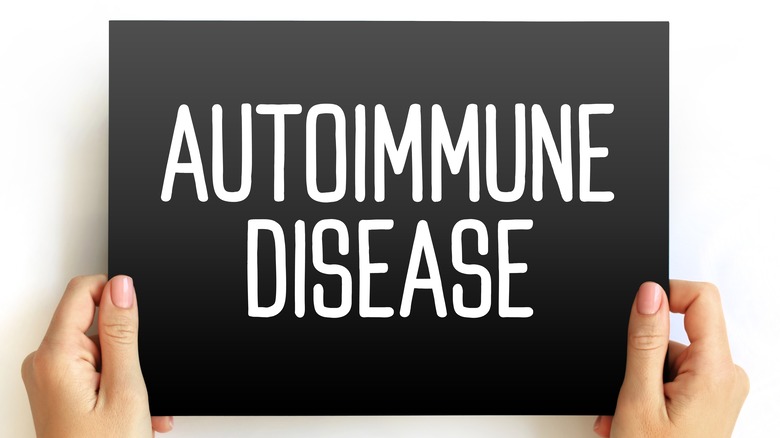Lupus Explained: Causes, Symptoms, And Treatment
Lupus is a chronic autoimmune disease that causes inflammation in several different body systems (via the Cleveland Clinic). The word "lupus" usually refers to systemic lupus erythematosus (SLE), the most common type of lupus. As noted in a 2020 abstract published in Lupus Science & Medicine, the term first came into use around 850 A.D. to describe lesions that looked very much like the bite of a wolf ("lupus" in Latin).
As an autoimmune disorder, lupus attacks healthy tissues, causing joint pain, fever, skin rashes, and damage to internal organs including the brain, lungs, kidneys, and heart (per the Cleveland Clinic). Lupus occurs much more frequently in women (mostly of reproductive age) than in men. While women with lupus can still become pregnant, they have a high risk of miscarriage and other complications; thus, they should arrange a preconception consult with their healthcare provider. It's also worth noting that lupus cannot be spread from person to person through touch or through air.
People with a genetic predisposition can develop lupus when triggered by environmental factors such as sunlight, infections, and certain medications, reports the Mayo Clinic. Although there is currently no cure for lupus, symptoms can be managed with medical treatments and lifestyle changes. Here's what you need to know about the disease.
Types of lupus
Several forms of lupus have been identified, reports Medical News Today. Most lupus cases (70%) are grouped under systemic lupus erythematosus (SLE), which causes inflammation in several organs and systems of the body, including the skin, joints, lungs, kidneys, blood, and heart. SLE is a more severe form of lupus characterized by recurring flare-ups which may occur often or only every few years, along with periods of remission during which all symptoms may subside. However, for some people, the disease remains active long-term. Meanwhile, drug-induced lupus (DIL), auses some of the same symptoms as SLE, though usually less severe and temporary (the disease disappears once the triggering medication is stopped). Long-term use of hydralazine (for hypertension) and procainamide (for heart arrythmia) are linked to DIL.
Per the Lupus Foundation of America, skin lesions occur in roughly two-thirds of people with lupus. Discoid lupus is a chronic form of lupus skin disease that is marked by disk-shaped, round lesions most often developing on the scalp and face. These red, scaly, and thick lesions can eventually lead to scarring and skin discoloration. Since the lesions are also very photosensitive, individuals with discoid lupus must minimize sun exposure. Neonatal lupus is a rare form of lupus that occurs in infants at birth who have antibodies passed on to them from their mothers during pregnancy. Whie affected infants may develop symptoms (e.g., a skin rash, liver issues, or low blood cell counts), they usually go away entirely after six months. Most mothers with lupus give birth to healthy babies.
Prevalence of lupus
Since there is no single diagnostic test to determine whether a person has lupus, and since many lupus characteristics are shared by related syndromes (e.g., mixed connective tissue disease), it's difficult to pinpoint the number of Americans afflicted with lupus, reports the Lupus Foundation of America. Nevertheless, it is estimated that around 1.5 million people in the U.S. are living with some variant of lupus. Lupus predominantly strikes women (90% of diagnosed cases) and mostly between the ages of 15 and 44 (via the Cleveland Clinic). Lupus is also more prevalent among African American, Hispanic, Asian, and Native American women than among white women.
The prevalence of lupus is also noteworthy among children and the elderly, notes the NIH. Compared to adults with SLE, children often develop more severe symptoms such as a butterfly rash on the face, inflammation of the kidneys, enlarged spleen, and blood abnormalities. In contrast, SLE develops in a more gradual manner among older people, but causes more lung problems. While lupus is rare in men, it is often more severe. Men often develop certain symptoms more frequently than women. These include skin lesions, kidney disease, neurologic problems, thrombosis, high blood pressure, and cardiovascular disease.
Causes of lupus
While the specific cause of lupus has not been established, it is clearly an autoimmune disease, reports Medical News Today. The immune system defends the body against toxins and foreign invaders such as bacteria, viruses, fungi, and other pathogens. Per the Merck Manual, these foreign substances and pathogens contain molecules called antigens that provoke the immune system to respond by producing antibodies to subdue the threat. However, a malfunction may occur whereby the immune system mistakenly recognizes the antigens (autoantigens) in a person's own healthy tissues as foreign, subsequently producing autoantibodies directed against healthy cells. Ultimately, this leads to inflammation and damage in specific types of tissues dependent on the type of autoimmune disease involved.
The autoantibodies produced in lupus and other autoimmune disorders are called antinuclear antibodies (ANAs), per Medical News Today. These ANAs bind and destroy components of the cell's nucleus, including proteins and DNA. Per a 2017 review in Clinical Immunology, the generation of ANAS and the abnormal immune responses characteristic of lupus partly result from various types of cell death and defective clearance of dying cells. Autophagy is one example of programmed cell death whereby damaged or expired cellular components and proteins are broken down and recycled into nutrients for the repair and maintenance of the cell. In lupus, however, autophagy and other forms of cell death are accelerated, while the clearance of the resulting debris is impaired. This leads to the accumulation of autoantigens and ANAs that contributes to the development of lupus, as well as lupus nephritis (kidney inflammation).
Triggers of lupus
As with most autoimmune diseases, reports the Mayo Clinic, the interaction between genetics and the environment plays major roles in the development of lupus. Apparently, an environmental agent triggers lupus in genetically susceptible individuals.
While in most people with lupus the trigger is unknown, some potential triggers include exposure to sunlight, infections, and certain medications (e.g., blood pressure meds, anti-seizure meds, and antibiotics). As noted by the Lupus Foundation of America, medications that sensitize a person to the sun can also stimulate lupus. These medications include sulfa drugs (e.g., Bactrim), sulfasalazine (Azulfadine), diuretics, and tetracycline drugs (e.g., minocycline). Exhaustion, emotional stress (e.g., illness, divorce), and physical stress (e.g., surgery, injury, pregnancy) can also induce lupus.
Since 9 of 10 people with lupus are females, it has been theorized that the predominantly female hormone estrogen is somehow associated with lupus. However, research has not identified any conclusive evidence of a connection between lupus and estrogen (or any other hormone).
Signs and symptoms of lupus
Since lupus can attack multiple parts of the body, it can cause a wide range of symptoms that typically come (flare-up) and go (remission), as described by the Cleveland Clinic.
Symptoms vary among people with lupus, and many of them are shared by other diseases. While rashes resulting from excessive sun exposure can develop on the hands or wrists, a hallmark sign of lupus is a butterfly-shaped rash across the nose and cheeks that typically lasts days to weeks. Hair loss can be caused by steroid medications or by scarring of the scalp induced by rashes. Other symptoms include headaches, chest pain, stomach pain, shortness of breath, swollen glands, depression, seizures, and Raynaud's disease.
According to the CDC, muscle and joint pain, particularly in the neck, thighs, shoulders, and upper arms, are very common in people with lupus. Like rashes, joint pain as well as fever and fatigue may occur as a result of sun or light sensitivity. In some people, sores may appear in the mouth, or the eyes may become dry or inflamed. Others may develop anemia, dangerous blood clots, memory loss, or confusion. Half of people with lupus suffer from lupus nephritis, an inflammation of the kidneys that can lead to weight gain, swollen ankles, high blood pressure, and impaired kidney function.
Complications of lupus
Per the NIH, inflammation and the production of autoantibodies caused by lupus can lead to organ damage and various complications. In people with lupus, including younger age groups, atherosclerosis (thickening of the arteries from plaque buildup) is accelerated along with a substantially greater risk of coronary artery disease. High blood pressure and cardiac inflammation likely play a role in the higher risk of heart disease.
Lupus nephritis commonly occurs early in the disease process and can lead to chronic kidney damage. Kidney failure resulting from lupus nephritis is a major cause of death in lupus patients, notes the Mayo Clinic. If lupus infiltrates the brain and central nervous system, episodes of dizziness, headaches, behavior changes, vision problems, strokes, and seizures may occur. Memory loss and confusion are frequent complications of lupus. Pregnancy-related complications include miscarriage, high blood pressure, and pre-term birth.
Complications of lupus can also be caused by side effects of medications (via the NIH). Prolonged use of steroids to treat lupus can cause osteoporosis, which is often not detected nor treated and linked to increased risk of fractures. Long-term steroid treatment is also associated with glaucoma, cataract, weight gain, infections, and poor diabetes control. Extended use of hydroxychloroquine can cause macular degeneration and retinopathy, both of which can lead to vision loss. A considerably increased risk of interstitial cystitis and bladder cancer is tied to the chemotherapy drug cyclophosphamide. Ultimately, through suppression of the immune system, lupus substantially increases infection risk, another leading cause of death in people with lupus.
Diagnosis of lupus
As explained by the NIH, the diagnosis of lupus is established by the combined evaluation of signs, symptoms, laboratory tests, imaging, and microscopic examination of tissues and cells. There is no one test or symptom that is definitive for lupus. Furthermore, several other disorders share features in common with lupus. For example, the joint pain often seen in people with lupus can mimic symptoms of rheumatoid arthritis. Also, some infections (hepatitis B and C) are also associated with joint pain, while others (HIV, EBV) can cause fever and fatigue, both common symptoms of lupus. Lupus-like symptoms are also observed in people with lymphomas, particularly non-Hodgkin's lymphoma. In many of these conditions that mimic lupus, the ANA test is often positive.
The ANA test detects the presence of antinuclear antibodies in the blood. It is the initial test performed, as more than 97% of people with SLE have a positive ANA. However, a positive ANA is also seen in other conditions, as well as in 20% of the healthy general public, particularly females and relatives of people with autoimmune disorders. Thus, a positive ANA test is not definitive for lupus and additional tests for more specific autoantibodies are subsequently performed (via the Merck Manual). In particular, anti-double-stranded DNA antibodies are extremely specific for SLE, but they have the disadvantage of occurring in only 70% of people with SLE. Other routine tests used in diagnosing lupus include complete blood count, urinalysis, and chemistry profile with renal and liver enzymes.
Treatment of lupus
According to the Merck Manual, the treatment of lupus is largely dependent upon the severity of the disease. For both mild and severe lupus cases, the antimalarial drug hydroxychloroquine (Plaquenil) is often used to keep flares under control and improve survival. Short-term treatment with NSAIDs (nonsteroidal anti-inflammatory drugs) can help manage mild disease, particularly joint pain. For severe disease, steroids such as methylprednisone given IV and prednisone given orally are first-line therapy. During the initial treatment phase, steroids are often combined with other immunosuppressants such as the chemotherapy drug cyclophosphamide (Cytoxan). Treatment of severe lupus can be as brief as 4 weeks or last as long as 12 weeks before improvement is seen. Maintenance of lupus (i.e., keeping flares in check) can be achieved with low-dose prednisone and other immunosuppressive drugs such as mycophenolate mofetil (CellCept) or azathioprine (Imuran).
The chemotherapy drug methotrexate can be used in cases of lupus that are resistant to treatment with hydroxychloroquine or low-dose prednisone, notes the Cleveland Clinic. If prednisone needs to be continued long-term, supplementation with calcium and vitamin D, as well as bisphosphonate drugs, may be advised to offset the increased risk of osteoporosis. Alternative options for treating lupus cases that do not respond to other types of therapy include biologic drugs, medications derived from living sources. Rituximab (Rituxan) is a monoclonal antibody that depletes immune cells that produce autoantibodies associated with organ /tissue damage and complications. Another biologic, belimumab (Benlysta), works via the same mechanism, but cannot be used for lupus cases involving the kidneys.
Lifestyle management of lupus
Lifestyle changes complementing medical treatment can help people with lupus better manage their disease and control flares, reports Medical News Today. People with lupus should not smoke, as it exacerbates symptoms and can lead to organ damage. Less alcohol consumption is also advised since it may interact with medical treatment and, when excessive, burden the liver. Beyond its benefits for overall health and well-being, moderate exercise is recommended for people with lupus to help them cope with mental and physical stresses that come with the disease. Low-impact exercises (e.g., walking, swimming, yoga, Pilates) are suggested to minimize joint inflammation while still burning calories and improving muscular strength.
Per the Mayo Clinic, maintaining regular doctor visits for medical checkups rather than only when needed may help prevent flares and complications. Minimizing exposure to ultraviolet light from the sun to prevent flares is also important. Protective clothing and a sunscreen with an SPF of at least 55 is recommended when being outdoors. Various alternative therapies may provide some benefit for people with lupus. For example, supplementation with the adrenal hormone DHEA (dehydroepiandrosterone) in conjunction with standard treatment may curb flares while acupuncture may help soothe muscle pain.
The stress of living with lupus can be mentally and socially challenging. Having a support system of family and friends and connecting with other people with lupus should be encouraged. Other antistress measures include reading (especially about the disease itself), meditating, listening to music, or keeping a journal.
Diet and supplements for people with lupus
As explained in a 2018 review in Experimental and Therapeutic Medicine, food contributes to the management of lupus through its provision of nutrients and impact on the gut microbiota. While a nutrient-dense diet rich in omega-3 fats can reduce lupus-related inflammation and help mitigate the comorbidities associated with lupus (e.g., diabetes, metabolic syndrome, obesity), it can also favorably alter the composition and function of the gut microbiota, which is linked to the development of lupus (and other autoimmune disorders) in genetically susceptible individuals.
One of the most effective dietary interventions is calorie restriction, which has been shown to prevent disease progression in animal models of autoimmune disease including lupus. Other dietary recommendations include increased consumption of whole grains, sea salt, and maple syrup and reduced consumption of refined grains, refined salt, and sugar. Fresh fish and cold pressed oil should be included in the diet, and fresh vegetables should be eaten daily, along with a least one fruit.
According to a review of complementary and alternative treatments for lupus published in Current Rheumatology Reports, some evidence suggests that certain supplements may improve symptoms of lupus, reduce disease activity, and lower the risk of comorbidities associated with lupus. Included among these supplements are vitamin D, vitamin C, omega-3 fatty acids, N-acetyl cysteine (NAC), and turmeric. Although studies are limited, these supplements may benefit cardiovascular and bone health, reduce oxidative stress (free radical damage), and decrease proteinuria (protein in the urine) in people with lupus.
Prognosis
In the past, lives were cut short by lupus, reports Healthline. Today, however, people with lupus are living longer and the prognosis for a normal lifespan is good.
As noted in the Merck Manual, more than 95% of people with lupus in developed countries will survive 10 years. Earlier diagnosis and treatment advancements are partly responsible for the greater survival rate. Along with kidney disease and infections, increased risk of cardiovascular disease is a major contributor to premature death in people with lupus (via the Lupus Foundation of America). Thus, people with lupus must be diligent about maintaining a healthful lifestyle (e.g., regular exercise, sensible diet, smoking cessation) to decrease risk factors for heart disease, including obesity, inactivity, and elevated serum cholesterol.
According to the NIH, routine monitoring and screening for heart disease as well as infections can flag the need for early therapy and thus help prolong survival. Nonetheless, certain factors are associated with a poor outlook for people with lupus. These factors include African American ethnicity, kidney disease, male sex, young age, high blood pressure, low socioeconomic status, and high overall disease activity.












